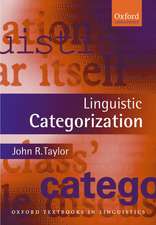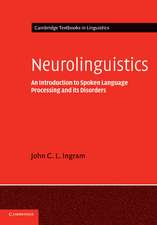Language in the Brain: Critical Assessments
Autor Fred C.C. Pengen Limba Engleză Paperback – 31 aug 2008
| Toate formatele și edițiile | Preț | Express |
|---|---|---|
| Paperback (1) | 259.98 lei 43-57 zile | |
| Bloomsbury Publishing – 31 aug 2008 | 259.98 lei 43-57 zile | |
| Hardback (1) | 1330.98 lei 43-57 zile | |
| Bloomsbury Publishing – 13 noi 2005 | 1330.98 lei 43-57 zile |
Preț: 259.98 lei
Preț vechi: 332.46 lei
-22% Nou
Puncte Express: 390
Preț estimativ în valută:
49.75€ • 51.63$ • 41.58£
49.75€ • 51.63$ • 41.58£
Carte tipărită la comandă
Livrare economică 17-31 martie
Preluare comenzi: 021 569.72.76
Specificații
ISBN-13: 9780826438843
ISBN-10: 0826438849
Pagini: 352
Dimensiuni: 156 x 234 x 18 mm
Greutate: 0.49 kg
Editura: Bloomsbury Publishing
Colecția Continuum
Locul publicării:London, United Kingdom
ISBN-10: 0826438849
Pagini: 352
Dimensiuni: 156 x 234 x 18 mm
Greutate: 0.49 kg
Editura: Bloomsbury Publishing
Colecția Continuum
Locul publicării:London, United Kingdom
Caracteristici
Has wide-reaching implications for the study of language disorders, neurolinguistics, and psycholinguistics in dealing with dementia, aphasia, and schizophrenia.
Cuprins
Introduction
I. What Is Language?
1.A Brief History of Linguistics: What Went Wrong?
2. Historical Perspective from the Point of View of Semiotics
3. Historical Perspective from the Medical and Paramedical Point of View
II. What Can Be Done about the Current Situations?
4. A Mild Proposal
III. The Individual Aspect of Parole
5. Language Behavior and Body Movements
6. The Physical Basis of Life
7. Embryonic Development of the Nervous System
8. Fetal Development of the Nervous System
9. Phylogenic and Ontogenic Origin of the Complexity of Neuronal Circuitry
10. Species-Specific Function of the Human Vocal Apparatus
11. Structural Divisions of the Nervous System
IV. The Individual Aspect of Langue
12. Language in the Brain is Memory-Governed
13. Language in the Brain is Meaning-Centered
14. Language in the Brain is Multifaceted
15. Language in the Brain is Stratified
16. Evolution of Language: What Evolved?
17. Cerebral Dominance and Cerebral Laterality; Fact or Fiction?
V. Production and Reception
18. Construction of Meaning: Mapping of Content onto Expression
19. Reconstruction of Meaning: Coupling of Expression and Content
VI. Summary and Conclusion
I. What Is Language?
1.A Brief History of Linguistics: What Went Wrong?
2. Historical Perspective from the Point of View of Semiotics
3. Historical Perspective from the Medical and Paramedical Point of View
II. What Can Be Done about the Current Situations?
4. A Mild Proposal
III. The Individual Aspect of Parole
5. Language Behavior and Body Movements
6. The Physical Basis of Life
7. Embryonic Development of the Nervous System
8. Fetal Development of the Nervous System
9. Phylogenic and Ontogenic Origin of the Complexity of Neuronal Circuitry
10. Species-Specific Function of the Human Vocal Apparatus
11. Structural Divisions of the Nervous System
IV. The Individual Aspect of Langue
12. Language in the Brain is Memory-Governed
13. Language in the Brain is Meaning-Centered
14. Language in the Brain is Multifaceted
15. Language in the Brain is Stratified
16. Evolution of Language: What Evolved?
17. Cerebral Dominance and Cerebral Laterality; Fact or Fiction?
V. Production and Reception
18. Construction of Meaning: Mapping of Content onto Expression
19. Reconstruction of Meaning: Coupling of Expression and Content
VI. Summary and Conclusion
Recenzii
"Peng explores the question "What is language?" from the perspective of neurolinguistics, which is based on neuroanatomy and neurophysiology... For linguists, neuroscientists, and academics researching any aspect of language and the brain."













